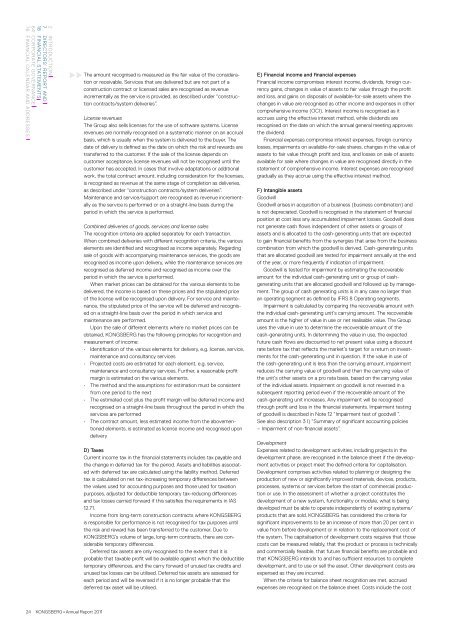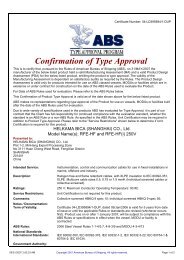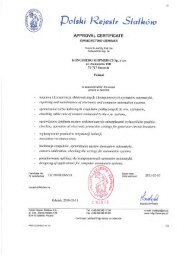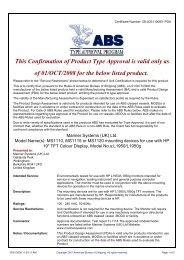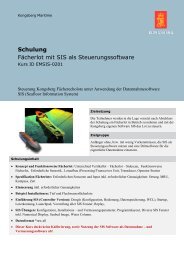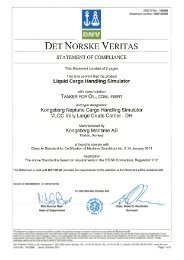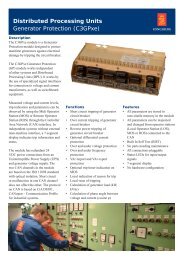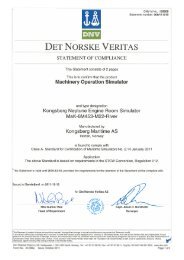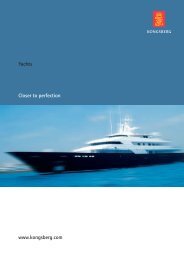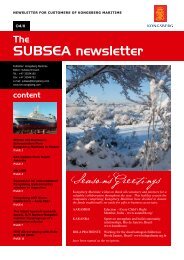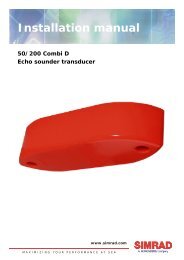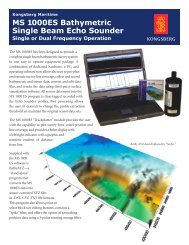Annual Report 2011 - Kongsberg Maritime - Kongsberg Gruppen
Annual Report 2011 - Kongsberg Maritime - Kongsberg Gruppen
Annual Report 2011 - Kongsberg Maritime - Kongsberg Gruppen
You also want an ePaper? Increase the reach of your titles
YUMPU automatically turns print PDFs into web optimized ePapers that Google loves.
2 INTRODUCTION<br />
7 DIRECTORS’ REPORT AND<br />
18 FINANCIAL STATEMENTS<br />
64 CORPORATE GOVERNANCE<br />
76 FINANCIAL CALENDAR AND ADDRESSES<br />
24<br />
KONGSBERG <strong>Annual</strong> <strong>Report</strong> <strong>2011</strong><br />
The amount recognised is measured as the fair value of the consideration<br />
or receivable. Services that are delivered but are not part of a<br />
construction contract or licensed sales are recognised as revenue<br />
incrementally as the service is provided, as described under “construction<br />
contracts/system deliveries”.<br />
License revenues<br />
The Group also sells licenses for the use of software systems. License<br />
revenues are normally recognised on a systematic manner on an accrual<br />
basis, which is usually when the system is delivered to the buyer. The<br />
date of delivery is defined as the date on which the risk and rewards are<br />
transferred to the customer. If the sale of the license depends on<br />
cus tomer acceptance, license revenues will not be recognised until the<br />
customer has accepted. In cases that involve adaptations or additional<br />
work, the total contract amount, including consideration for the licenses,<br />
is recognised as revenue at the same stage of completion as deliveries,<br />
as described under “construction contracts/system deliveries”.<br />
Main tenance and service/support are recognised as revenue incrementally<br />
as the service is performed or on a straight-line basis during the<br />
period in which the service is performed.<br />
Combined deliveries of goods, services and license sales<br />
The recognition criteria are applied separately for each transaction.<br />
When combined deliveries with different recognition criteria, the various<br />
elements are identified and recognised as income separately. Regarding<br />
sale of goods with accompanying maintenance services, the goods are<br />
recognised as income upon delivery, while the maintenance services are<br />
recognised as deferred income and recognised as income over the<br />
period in which the service is performed.<br />
When market prices can be obtained for the various elements to be<br />
delivered, the income is based on these prices and the stipulated price<br />
of the license will be recognised upon delivery. For service and main tenance,<br />
the stipulated price of the service will be deferred and recognised<br />
on a straight-line basis over the period in which service and<br />
maintenance are performed.<br />
Upon the sale of different elements where no market prices can be<br />
obtained, KONGSBERG has the following principles for recognition and<br />
measurement of income:<br />
• Identification of the various elements for delivery, e.g. license, service,<br />
maintenance and consultancy services<br />
• Projected costs are estimated for each element, e.g. service,<br />
maintenance and consultancy services. Further, a reasonable profit<br />
margin is estimated on the various elements.<br />
• The method and the assumptions for estimation must be consistent<br />
from one period to the next<br />
• The estimated cost plus the profit margin will be deferred income and<br />
recognised on a straight-line basis throughout the period in which the<br />
services are performed<br />
• The contract amount, less estimated income from the abovementioned<br />
elements, is estimated as license income and recognised upon<br />
delivery<br />
D) Taxes<br />
Current income tax in the financial statements includes tax payable and<br />
the change in deferred tax for the period. Assets and liabilities associated<br />
with deferred tax are calculated using the liability method. Deferred<br />
tax is calculated on net tax-increasing temporary differences between<br />
the values used for accounting purposes and those used for taxation<br />
purposes, adjusted for deductible temporary tax-reducing differences<br />
and tax losses carried forward if this satisfies the requirements in IAS<br />
12.71.<br />
Income from long-term construction contracts where KONGSBERG<br />
is responsible for performance is not recognised for tax purposes until<br />
the risk and reward has been transferred to the customer. Due to<br />
KONGSBERG’s volume of large, long-term contracts, there are considerable<br />
temporary differences.<br />
Deferred tax assets are only recognised to the extent that it is<br />
probable that taxable profit will be available against which the deductible<br />
temporary differences, and the carry forward of unused tax credits and<br />
unused tax losses can be utilised. Deferred tax assets are assessed for<br />
each period and will be reversed if it is no longer probable that the<br />
deferred tax asset will be utilised.<br />
E) Financial income and financial expenses<br />
Financial income compromises interest income, dividends, foreign currency<br />
gains, changes in value of assets to fair value through the profit<br />
and loss, and gains on disposals of available-for-sale assets where the<br />
changes in value are recognised as other income and expenses in other<br />
comprehensive income (OCI). Interest income is recognised as it<br />
ac crues using the effective interest method, while dividends are<br />
recognised on the date on which the annual general meeting approves<br />
the dividend.<br />
Financial expenses compromise interest expenses, foreign currency<br />
losses, impairments on available-for-sale shares, changes in the value of<br />
assets to fair value through profit and loss, and losses on sale of assets<br />
available for sale where changes in value are recognised directly in the<br />
statement of comprehensive income. Interest expenses are recognised<br />
gradually as they accrue using the effective interest method.<br />
F) Intangible assets<br />
Goodwill<br />
Goodwill arises in acquisition of a business (business combination) and<br />
is not depreciated. Goodwill is recognised in the statement of financial<br />
position at cost less any accumulated impairment losses. Goodwill does<br />
not generate cash flows independent of other assets or groups of<br />
assets and is allocated to the cash-generating units that are expected<br />
to gain financial benefits from the synergies that arise from the business<br />
combination from which the goodwill is derived. Cash-generating units<br />
that are allocated goodwill are tested for impairment annually at the end<br />
of the year, or more frequently if indication of impairment.<br />
Goodwill is tested for impairment by estimating the recoverable<br />
amount for the individual cash-generating unit or group of cash-<br />
generating units that are allocated goodwill and followed up by management.<br />
The group of cash generating units is in any case no larger than<br />
an operating segment as defined by IFRS 8 Operating segments.<br />
Impairment is calculated by comparing the recoverable amount with<br />
the individual cash-generating unit’s carrying amount. The recoverable<br />
amount is the higher of value in use or net realisable value. The Group<br />
uses the value in use to determine the recoverable amount of the<br />
cash-generating units. In determining the value in use, the expected<br />
future cash flows are discounted to net present value using a discount<br />
rate before tax that reflects the market’s target for a return on investments<br />
for the cash-generating unit in question. If the value in use of<br />
the cash-generating unit is less than the carrying amount, impairment<br />
reduces the carrying value of goodwill and then the carrying value of<br />
the unit’s other assets on a pro rata basis, based on the carrying value<br />
of the individual assets. Impairment on goodwill is not reversed in a<br />
subsequent reporting period even if the recoverable amount of the<br />
cash-generating unit increases. Any impairment will be recognised<br />
through profit and loss in the financial statements. Impairment testing<br />
of goodwill is described in Note 12 “Impairment test of goodwill “.<br />
See also description 3 I) “Summary of significant accounting policies<br />
– Impairment of non-financial assets”.<br />
Development<br />
Expenses related to development activities, including projects in the<br />
development phase, are recognised in the balance sheet if the development<br />
activities or project meet the defined criteria for capitalisation.<br />
Development comprises activities related to planning or designing the<br />
production of new or significantly improved materials, devices, products,<br />
processes, systems or services before the start of commercial production<br />
or use. In the assessment of whether a project constitutes the<br />
development of a new system, functionality or module, what is being<br />
developed must be able to operate independently of existing systems/<br />
products that are sold. KONGSBERG has considered the criteria for<br />
significant improvements to be an increase of more than 20 per cent in<br />
value from before development or in relation to the replacement cost of<br />
the system. The capitalisation of development costs requires that those<br />
costs can be measured reliably, that the product or process is technically<br />
and commercially feasible, that future financial benefits are probable and<br />
that KONGSBERG intends to and has sufficient resources to complete<br />
development, and to use or sell the asset. Other development costs are<br />
expensed as they are incurred.<br />
When the criteria for balance sheet recognition are met, accrued<br />
expenses are recognised on the balance sheet. Costs include the cost


